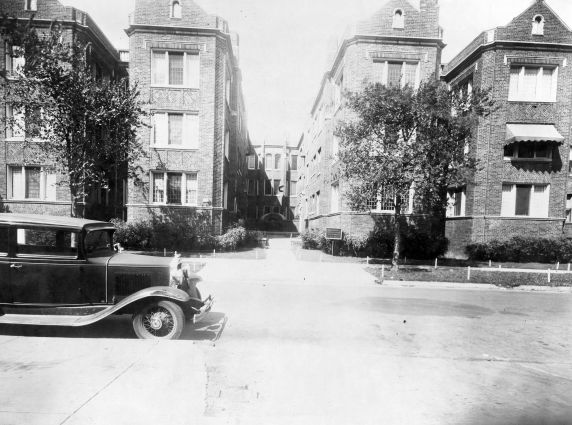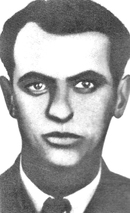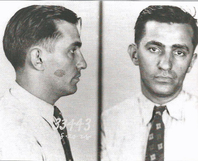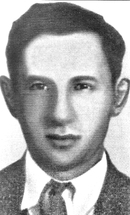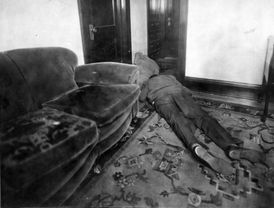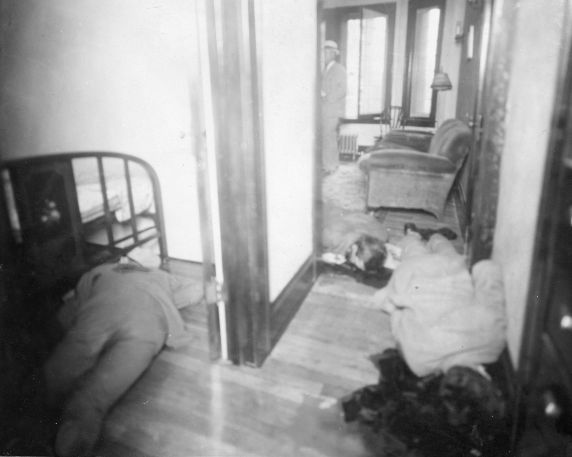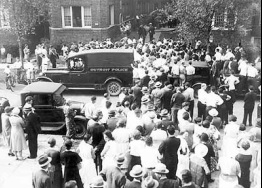The final straw
For several years, the Purple Gang seemingly enjoyed complete immunity from police interference as witnesses to crimes were terrified of testifying against any criminal identified as being associated with the gang.
This believe of invincibility, however, led the gang to become more arrogant and sloppy as time progressed. They dressed
flamboyantly, were regulars in the city’s night spots and openly flaunted their money and power. This began to turn the public against the gang and, in turn, there was more pressure on police to clean up the city's crime element. Internally, petty jealousies, egos and quarrels began to set the stage for the gang’s ultimate collapse.
Although cracks were beginning to surface in the gang’s wall of protection, it was the Collingwood Manor Massacre of 1931 that would deal the death blow.
Seeds of the massacre were actually sown early in the gang's evolution. One of the gang's first major activities was the hijacking of liquor from rum runners along the Detroit River. Eventually, the gang began smuggling liquor in consortium with a small Purple Gang sub-group, known as the “Little Jewish Navy.” This group was responsible for trafficking liquor from Canada by boat and included three former Chicago thieves -Joseph "Nigger Joe" Lebowitz, Herman "Hymie" Paul and Isadore "Izzy the Rat" Sutker. In time, the three attempted to establish themselves as an independent power. Calling themselves the “Third Avenue Terrors,” they tried to muscle in on a piece of the Purple Gang's territory.
As tensions grew, Purple Gang leader Ray Bernstein decided to eliminate them and to use gang associate Sol Levine as an unknown accomplice to the crime. Levine was a good friend of both groups, and probably believed he was going to serve as a mediator after
Bernstein convinced him that his gang had decided to give the trio a small piece of its liquor business.
The meeting was called for Sept. 16, 1931, and the three men, escorted by Levine, went to apartment 211 at 1740 Collingwood Ave. Once inside, there was some general conversation before
Bernstein excused himself to get something from his car. Once in the car, he honked the horn as a signal to Harry Keywell, Irving Milberg and Harry Fleisher, three Purple Gang members who had remained in
the apartment.
Without warning, Fleisher stood, pulled out a revolver and shot Lebowitz at point blank range. Milberg and Keywell also stood and began firing at the other two, Keywell shooting Sutker and Milberg Paul. Levine was untouched on orders from Bernstein and simply watched in shock.
The three shooters then left the apartment, got into Berstein's car and the four drove off.
When police arrived, Levine was still at the scene and was taken to headquarters for questioning. Likely fearing for his own life, he eventually admitted to seeing the murders take place and named the shooters.
Shortly after Levine confessed, police received an anonymous call in which the caller stated, "Two of the men you want for the Collingwood murder are at 2649 Calvert. They will be out of town within the hour." Heavily armed police went to the location which was
owned by Charles Aurbach, an underworld consultant and Purple Gang member. Bernstein and Keywell were arrested. They had been sitting in their pajamas and playing cards when police arrived. Milberg was arrested the following night as he was about to leave town. The guns were also recovered, tests proved they were the murder weapons and police were able to tie the weapons to the shooters.
The pretrial examination began on Sept. 30, 1931. A frightened Levine pointed to Bernstein, Keywell, Milberg and Fleisher, naming them as the men that killed Lebowitz, Paul and Sutker. During his testimony, Levine focused solely on the prosecutor, not once looking at the accused men, according to newspaper accounts. However, Bernstein, Keywell, Milberg and Fleisher focused mainly on Levine, glaring at him during the entire proceedings.
On Oct 2, 1931, the men were arraigned before Judge Donald Van Zile. A defense motion for dismissal of all charges was denied and the four were ordered to be held without bond.
The trial began on Nov. 2, and Levine, surrounded by 10 armed detectives because he feared for his life, began his account of
what happened on the day of the massacre. Levine was followed by
several witnesses who testified to having seen the men run from
the building just moments after hearing shots fired.
It took the jury an hour and 37 minutes to return guilty verdicts. Each
was sentenced to life in prison without parole. They were sent to
Marquette prison, Michigan's maximum security facility.
Chief of detectives James E. McCarty made a statement to the press saying, "This conviction is the greatest accomplishment in years. Not only does it break the back of the Purple Gang but it serves notice on other mobs that murder doesn't go anymore in Detroit."
The convictions crippled the Purple Gang’s influence. Inner-gang
rivalries and disputes, arrests and convictions and multiple murders by rival gangs quickly took a toll on the gang.
Other criminal organizations began to rapidly fill the void left by the Purple Gang’s dismantled empire. As members fled Detroit, were killed or imprisoned, the once feared Purple Gang simply self-destructed.
This believe of invincibility, however, led the gang to become more arrogant and sloppy as time progressed. They dressed
flamboyantly, were regulars in the city’s night spots and openly flaunted their money and power. This began to turn the public against the gang and, in turn, there was more pressure on police to clean up the city's crime element. Internally, petty jealousies, egos and quarrels began to set the stage for the gang’s ultimate collapse.
Although cracks were beginning to surface in the gang’s wall of protection, it was the Collingwood Manor Massacre of 1931 that would deal the death blow.
Seeds of the massacre were actually sown early in the gang's evolution. One of the gang's first major activities was the hijacking of liquor from rum runners along the Detroit River. Eventually, the gang began smuggling liquor in consortium with a small Purple Gang sub-group, known as the “Little Jewish Navy.” This group was responsible for trafficking liquor from Canada by boat and included three former Chicago thieves -Joseph "Nigger Joe" Lebowitz, Herman "Hymie" Paul and Isadore "Izzy the Rat" Sutker. In time, the three attempted to establish themselves as an independent power. Calling themselves the “Third Avenue Terrors,” they tried to muscle in on a piece of the Purple Gang's territory.
As tensions grew, Purple Gang leader Ray Bernstein decided to eliminate them and to use gang associate Sol Levine as an unknown accomplice to the crime. Levine was a good friend of both groups, and probably believed he was going to serve as a mediator after
Bernstein convinced him that his gang had decided to give the trio a small piece of its liquor business.
The meeting was called for Sept. 16, 1931, and the three men, escorted by Levine, went to apartment 211 at 1740 Collingwood Ave. Once inside, there was some general conversation before
Bernstein excused himself to get something from his car. Once in the car, he honked the horn as a signal to Harry Keywell, Irving Milberg and Harry Fleisher, three Purple Gang members who had remained in
the apartment.
Without warning, Fleisher stood, pulled out a revolver and shot Lebowitz at point blank range. Milberg and Keywell also stood and began firing at the other two, Keywell shooting Sutker and Milberg Paul. Levine was untouched on orders from Bernstein and simply watched in shock.
The three shooters then left the apartment, got into Berstein's car and the four drove off.
When police arrived, Levine was still at the scene and was taken to headquarters for questioning. Likely fearing for his own life, he eventually admitted to seeing the murders take place and named the shooters.
Shortly after Levine confessed, police received an anonymous call in which the caller stated, "Two of the men you want for the Collingwood murder are at 2649 Calvert. They will be out of town within the hour." Heavily armed police went to the location which was
owned by Charles Aurbach, an underworld consultant and Purple Gang member. Bernstein and Keywell were arrested. They had been sitting in their pajamas and playing cards when police arrived. Milberg was arrested the following night as he was about to leave town. The guns were also recovered, tests proved they were the murder weapons and police were able to tie the weapons to the shooters.
The pretrial examination began on Sept. 30, 1931. A frightened Levine pointed to Bernstein, Keywell, Milberg and Fleisher, naming them as the men that killed Lebowitz, Paul and Sutker. During his testimony, Levine focused solely on the prosecutor, not once looking at the accused men, according to newspaper accounts. However, Bernstein, Keywell, Milberg and Fleisher focused mainly on Levine, glaring at him during the entire proceedings.
On Oct 2, 1931, the men were arraigned before Judge Donald Van Zile. A defense motion for dismissal of all charges was denied and the four were ordered to be held without bond.
The trial began on Nov. 2, and Levine, surrounded by 10 armed detectives because he feared for his life, began his account of
what happened on the day of the massacre. Levine was followed by
several witnesses who testified to having seen the men run from
the building just moments after hearing shots fired.
It took the jury an hour and 37 minutes to return guilty verdicts. Each
was sentenced to life in prison without parole. They were sent to
Marquette prison, Michigan's maximum security facility.
Chief of detectives James E. McCarty made a statement to the press saying, "This conviction is the greatest accomplishment in years. Not only does it break the back of the Purple Gang but it serves notice on other mobs that murder doesn't go anymore in Detroit."
The convictions crippled the Purple Gang’s influence. Inner-gang
rivalries and disputes, arrests and convictions and multiple murders by rival gangs quickly took a toll on the gang.
Other criminal organizations began to rapidly fill the void left by the Purple Gang’s dismantled empire. As members fled Detroit, were killed or imprisoned, the once feared Purple Gang simply self-destructed.
